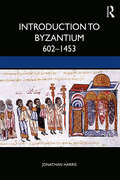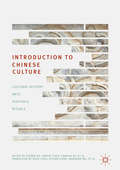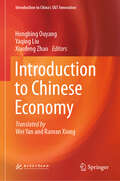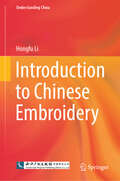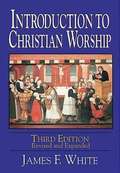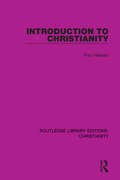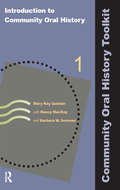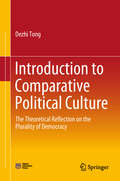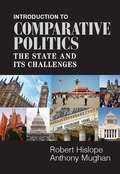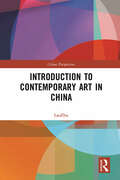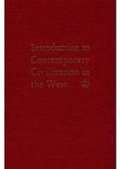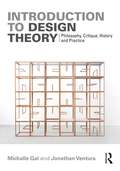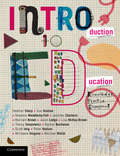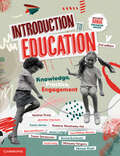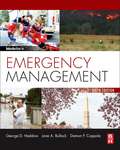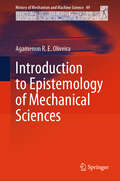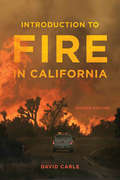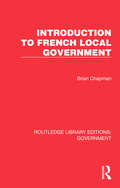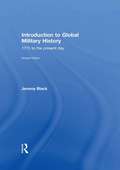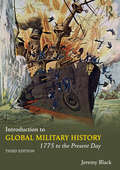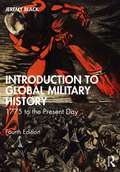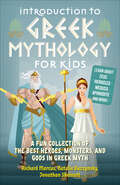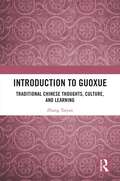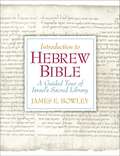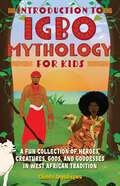- Table View
- List View
Introduction to Byzantium, 602–1453
by Jonathan HarrisIntroduction to Byzantium, 602–1453 provides students with an accessible guide to medieval Byzantium. Beginning with the near collapse of Byzantium in the seventh century, the book traces its survival and development through to its absorption by the Ottoman empire. As well as having an overall political narrative, the chapters cover a wide range of topics including society and economy, art and architecture, literature and education, military tactics and diplomacy, gender and education. They also explore themes that remain prominent and highly debated today, including relations between Islam and the West, the impact of the Crusades, the development of Russia, and the emergence of Orthodox Christianity. Comprehensively written, each chapter provides an overview of the particular period or topic, a summary of the ongoing historiographical debates, primary source material textboxes, further reading recommendations and a ‘points to remember’ section. Introduction to Byzantium, 602–453 provides students with a thorough introduction to the history of Byzantium and equips them with the tools to write successful analytical essays. It is essential reading for any student of the history of the Byzantine empire.
Introduction to Chinese Culture: Cultural History, Arts, Festivals And Rituals
by Guobin Xu Yanhui Chen Lianhua XuPromoting cultural understanding in a globalized world, this text is a key tool for students interested in understanding the fundamentals of Chinese culture. Written by a team of experts in their fields, it offers a comprehensive and detailed introduction to Chinese culture and addresses the fundamentals of Chinese cultural and social development. It notably considers Chinese traditional culture, medicine, arts and crafts, folk customs, rituals and etiquette, and is a key read for scholars and students in Chinese Culture, History and Language.
Introduction to Chinese Economy (Introduction to China's S&T Innovation)
by Hongbing Ouyang Yaqing Liu Xiaofeng ZhaoThe original version of this book is a bilingual book for international students and overseas readers, which is included in the “Introduction to China’s S&T Innovation”, a project funded by the Hubei Provincial Public Welfare Academic Publication Special Funds in 2024. The book consists of 14 chapters. Based on the introduction of the historical foundation and natural conditions of China's economic development, it introduces the history of China's economic development in stages such as before 1949, 1949-1978, after 1978, and the new period; and then in the form of special topics it discusses China's opening up to the outside world and international trade , rural reform and agricultural modernization, reform of the state-owned enterprise system with Chinese characteristics, industrialization and urbanization, and reform of the state-owned enterprise system with Chinese characteristics, industrialization process and urban development, macro-economic policy and fiscal and taxation system, and the reform and establishment of modern financial system; and finally, it introduces the economic development model with Chinese characteristics, the development concept and development pattern in the new era. The book explains the policy background and internal logic of China's economic growth, reflects the achievements and experience of China's economic reform, and tells the world the story of China's economic miracle in a clear, concise, and easy-to-understand manner.
Introduction to Chinese Embroidery (Understanding China)
by Hongfu LiThis book provides a comprehensive introduction to Chinese embroidery, including its history, styles in different regions, patterns, techniques, and its appreciation. It serves as the first guidebook in the international community for scholars, students either at undergraduate or postgraduate level, artists, and other interested general audience to get a bird’s-eye view of Chinese embroidery. Through this book, readers will not only acquire a general understanding of this brilliant folk art, but also be carried away by the sophistication and exquisiteness of a legion of embroidery works created by Chinese artists.
Introduction to Christian Worship (3rd Edition, Revised and Expanded)
by James F. WhiteThis Edition traces the development of the major forms of Christian worship and includes discussion of the newest service books of the principal churches of North America and the British Isles. This liturgical history is used widely in Protestant seminaries and is read by clergy and laity alike as an accurate, informative, and accessible introduction to all aspects of Christian worship.
Introduction to Christianity
by Paul HessertOriginally published in 1958, Introduction to Christianity considers the nature of Christianity as a life shared in an historical, continuing community. Divided into five parts, the book is a comprehensive interpretation of Christianity as a people created by God’s activity in history, with a focus on the proclamation of the Gospel. It highlights and examines the relevance of Christian doctrine to reflections on the meaning of life, and considers the significance of this at a time in which attitudes towards religion are increasingly ambiguous. Introduction to Christianity is ideal for those with an interest in the history of Christianity, Christian theology, and religious philosophy.
Introduction to Community Oral History (Community Oral History Toolkit #1)
by Nancy MacKay Barbara W Sommer Mary Kay QuinlanThe first book of the five-volume Community Oral History Toolkit sets the stage for an oral history project by placing community projects into a larger context of related fields and laying a sound theoretical foundation. It introduces the field of oral history to newcomers, with discussions of the historical process, the evolution of oral history as a research methodology, the nature of community, and the nature of memory. It also elaborates on best practices for community history projects and presents a detailed overview of the remaining volumes of the Toolkit, which cover Planning, Management, Interviewing, and After-the-Interview processing and curation. Introduction to Community Oral History features a comprehensive glossary, index, bibliography, and references, as well as numerous sample forms that are needed throughout the process of conducting community oral history projects.
Introduction to Comparative Political Culture: The Theoretical Reflection on the Plurality of Democracy
by Dezhi TongThis book starts with four aspects - subject’s cognition, way of thinking, political value and ideology, conducts comparative studies on political culture. Amid using the concept of political culture in western academic circles, it makes comprehensive supplement for this concept, and put forward an updated concept of political culture which is more localized. This new concept, on the grounds of the comparison with political system, takes political culture as the subjective side of political system and incorporates ideology into political culture, thus undoubtedly enriching our knowledge of political culture. On the basis of clarifying the concept of political culture and establishing the comparative dimension of it, this book widely refers to the outlooks of individuals, nations, society and power of political cognition; the modes of objectives, directions and methods of political ideas; democratic awareness, legal concept and system selection of political value; as well as liberalism and republicanism, etc. All these bring substantial benefits to promoting and deepening the comparative studies on political culture. This book can not only be used for the teaching undergraduate and graduates who major in Politics, but also used as the reference book for politics academic research.
Introduction to Comparative Politics
by Robert Hislope Anthony MughanThis stimulating and accessible introduction to comparative politics offers a fresh perspective on the fundamentals of political science. Its central theme is the enduring political significance of the modern state despite severe challenges to its sovereignty. There are three main sections to the book. The first traces the origins and meaning of the state and proceeds to explore its relationship to the practice of politics. The second examines how states are governed and compares patterns of governance found in the two major regime types in the world today, democracy and authoritarianism. The last section discusses several contemporary challenges – globalization, ethnic nationalism, terrorism and organized crime – to state sovereignty. Designed to appeal to students and professors alike, this lively text engages readers as it traces states' struggles against the mutually reinforcing pressures of global economic and political interdependence, fragmented identities and secessionism, transnational criminal networks, and terrorism.
Introduction to Contemporary Art in China (China Perspectives)
by Lao ZhuThe book is a collection of fifteen introductory essays excerpted from the Annual of Contemporary Art in China, covering the years from 2005 to 2019, showcasing the development and changing landscapes of contemporary art in China. The Annual documents exhibitions, events, creative practices, and critical literature concerning contemporary art in China since 2005. Based on archival documentation and statistics data from these annuals, notable phenomena, events, and discourses from a given year, as well as key works and artists are reviewed in each introduction, with no ideological or market-driven undertone. The author unravels industrial and institutional factors, while also broaching important issues of abstract art, new media art and so on, and probing the historical and socio-cultural context as well. In this regard, the book offers a panorama of contemporary Chinese art and critically engages with the art scene in China, including Hongkong, Taiwan, and among the Chinese diaspora. The title will appeal to scholars, students and general readers interested in contemporary art history, art criticism, contemporary Chinese art, iconography, and contemporary art theory.
Introduction to Contemporary Civilization in the West: Volume 1
by Columbia College Contemporary Civilization StaffCivilization -- History -- Sources.
Introduction to Design Theory: Philosophy, Critique, History and Practice
by Jonathan Ventura Michalle GalIntroduction to Design Theory introduces a comprehensive, systematic, and didactic outline of the discourse of design. Designed both as a course book and a source for research, this textbook methodically covers the central concepts of design theory, definitions of design, its historical milestones, and its relations to culture, industry, body, ecology, language, society, gender and ideology. Demonstrated by a shift towards the importance of the sociocultural context in which products are manufactured and embedded, this book showcases design theory as an emerging sub-discipline of design, unique in its practice-based approach and its broad perception of design. It offers an in-depth understanding of the central concepts, such as "form" and "function", "theory" and "practice", through a discussion of key case studies and historical examples, such as the advent of the view of design in antiquity, the introduction of mass production to modernist design or the ideological shifts in design in the mid-twentieth century, as well as analytical tools for further dissection and learning in practice. With a focus on a combination of several theoretical knowledge foundations — aesthetics and philosophy, critical theories, cultural studies, design history and design anthropology — the reader is enabled to approach design as a central pivot around which contemporary culture revolves, reflecting, reaffirming or challenging social and cultural structures. Aimed towards undergraduate and postgraduate students, as well as teachers and scholars, from across the design disciplines, Introduction to Design Theory invites readers to engage with design from an interdisciplinary perspective, departing from the traditional academic compartmentalisation of practice, history and philosophy.
Introduction to Education: Knowledge, Practice, Engagement
by Michael Walsh Peter Hudson Bernard Brown Heather Sharp Sue Hudson Noelene Weatherby-Fell Jennifer Charteris Jason Lodge Lisa McKay-Brown Tracey Sempowicz Rachel Buchanan Scott Imig Michaela VerganoIntroduction to Education provides pre-service teachers with an overview of the context, craft and practice of teaching in Australian schools as they commence the journey from learner to classroom teacher. Each chapter poses questions about the nature of teaching students, and guides readers though the Australian Professional Standards for Teachers. Incorporating recent research and theoretical literature, Introduction to Education presents a critical consideration of the professional, policy and curriculum contexts of teaching in Australia. The book covers theoretical topics in chapters addressing assessment, planning, safe learning environments, and working with colleagues, families, carers and communities. More practical chapters discuss professional experience and building a career after graduation. Rigorous in conception and practical in scope, Introduction to Education welcomes new educators to the theory and practical elements of teaching, learning, and professional practice.
Introduction to Education: Knowledge, Practice, Engagement
by Michael Walsh Sarah James Bernard Brown Heather Sharp Noelene Weatherby-Fell Jennifer Charteris Jason Lodge Lisa McKay-Brown Tracey Sempowicz Rachel Buchanan Scott Imig Michaela VerganoThe transition from student to classroom teacher presents many opportunities and challenges. Introduction to Education welcomes pre-service teachers to the field of education, providing an overview of the context, craft and practice of teaching in Australian schools. Each chapter poses a question about the nature of teaching and explores authentic classroom examples, contemporary research and literature, and the professional, policy and curriculum contexts of teaching. Thoroughly updated, the second edition continues to cover both theoretical and practical topics, with chapters addressing assessment, planning, safe learning environments, professional experience, and working with colleagues, families, caregivers and communities. Each chapter features: chapter opening stimulus materials and questions to activate prior learning and challenge assumptions; connections to policy and research with questions to encourage critical thinking and professional literacy; voices of educators and students that provide authentic classroom examples of the practical application of theory.
Introduction to Emergency Management (6th Edition)
by Damon P. Coppola Jane A. Bullock George D. HaddowIntroduction to Emergency Management sets the standard for excellence in the field and has educated a generation of emergency managers. Haddow, Bullock, and Coppola return for the sixth edition with an emphasis on climate change as a major hazard. Fully updated throughout for new regulations and workflows, with new case studies covering the latest in best practices, this classic textbook prepares students for the challenges of a career in emergency management. Expanded information on disaster recovery coordination structures; Emphasis on climate change as a key hazard faced by disaster managers; Coverage of social media as critical tool in emergency management; Fully updated throughout for the latest regulations and workflows; New examples and case studies throughout; Updated ancillaries to keep course instruction fresh.
Introduction to Epistemology of Mechanical Sciences (History of Mechanism and Machine Science #49)
by Agamenon R. OliveiraThis book investigates the development of mechanical sciences with a focus on epistemological issues. It examines the precursors and fundamental milestones of Newton's theory of motion, a geometry of motion since Greek antiquity, the influences of Robert Hooke on Newton's studies on the orbital motion of the planets, and finally, the orbital motion model with a central force inversely proportional to the square of the distance to this centre. By looking at the development of mechanics throughout history, especially with a careful look at epistemological issues, the book highlights the multiple relationships that the mechanical sciences build with other sciences, the economy, and the popular culture.
Introduction to Fire in California: Second Edition (California Natural History Guides)
by David CarleThe essential guide to California's long relationship with fire, updated for the climate-change generation. What is fire? How are wildfires ignited? How do California's weather and topography influence fire? How did Indigenous people use fire on the land we now call California? David Carle's clearly written, dramatically illustrated first edition of Introduction to Fire in California helped Californians, including the millions who live near naturally flammable wildlands, better understand their own place in the state's landscape. In this revised edition, Carle covers the basics of fire ecology; looks at the effects of fire on people, wildlife, soil, water, and air; discusses fire-fighting organizations and land-management agencies; and explains how to prepare for an emergency and what to do when one occurs. This second edition brings the wildfire story up to the year 2020, with information about recent extreme and deadly fire events and the evidence that climate change is swiftly changing the wildfire story in California. This update reflects current debates about California's future as a climate-crisis leader facing massive, annual natural disasters; the future of California development and housing; and the critically necessary alternatives to traditional energy options. Features:A larger, more reader-friendly page formatMore than 110 color illustrations and mapsAn overview of major wildfires in California's historyAn updated and expanded discussion of the effect of climate change on fires in natural landscapesTips on what to do before, during, and after firesDiscussion of utility companies and massive power shutoffs
Introduction to French Local Government (Routledge Library Editions: Government)
by Brian ChapmanOriginally published in 1953, this was the first post-War study in either English or French of the institutions and law relating to French local government and on the practice of French local administration. It is a study in political science and therefore, although the basic laws governing local institutions are dealt with in some detail, the aim is to give a picture of those institutions at work in the middle of the 20th Century. The book assumes no prior knowledge of the subject and will be of interest to students of French government and comparative political institutions.
Introduction to Global Military History: 1775 to the Present Day
by Jeremy BlackThis lucid account of military developments around the modern world begins with the American War of Independence and the French revolutionary wars and continues chronologically to the latest 21st century conflicts. It combines determinedly global coverage with thought-provoking analysis not only of the military aspects of conflict but also its social, cultural, political and economic dimensions and consequences. By placing familiar events alongside the largely unknown, the reader is forced to reassess the standard grand narrative of military history that rests on assumptions of Western cultural and technological superiority. It will be essential reading for students worldwide, whether studying modern military history, modern world history, history and international relations or war and society. This fully updated second edition includes: chapter introductions and conclusions to assist study and revision 'Voices of War' sourced extracts from the field of conflict case studies in each chapter to support the narrative and provoke discussion a 12-page colour map section and over 20 other integrated maps annotated references from the latest publications in the field
Introduction to Global Military History: 1775 to the Present Day
by Jeremy BlackIntroduction to Global Military History provides a lucid and comprehensive account of military developments around the modern world from the eighteenth century up to the present day. Beginning with the background to the American War of Independence and the French Revolutionary wars and ending with the recent conflicts of the twenty-first century, this third edition combines fully up-to-date global coverage with close analysis not only of the military aspects of war but also its social, cultural, political and economic dimensions and repercussions. The new edition includes a fully revised chapter on conflicts during the eighteenth century, updated coverage of events post-1990 and increased coverage of non-Western conflicts to provide a truly international account of the varied and changing nature of modern military history. Covering lesser-known conflicts as well as the familiar wars of history and illustrated throughout with maps, primary source extracts and case studies, it is essential reading for all students of modern military history and international relations.
Introduction to Global Military History: 1775 to the Present Day
by Jeremy BlackNow in its fourth edition, Introduction to Global Military History is an accessible, up-to-date account of modern warfare from the eighteenth century to the present.The book engages with the social, cultural, political and economic contexts of war, examining the causes and consequences of conflict beyond national and chronological boundaries. It challenges the dominant Western-centric, technologically focused view of military history and instead emphasises the ranges of circumstances faced by both Western and non-Western powers and the absence of any one direction of development. The chapters present integrated discussions of land, naval and air conflicts, addressing continuities and the ways in which common experiences affected different spheres. This edition revises the text throughout, has increased focus on the developments of the 2000s and 2010s, and adds a new chapter on the 2020s.Supported by a variety of illustrations, maps and case studies, this study is a valuable resource for students of military history and general readers alike.
Introduction to Greek Mythology for Kids: A Fun Collection of the Best Heroes, Monsters, and Gods in Greek Myth
by Richard Marcus Natalie Buczynsky Jonathan ShelnuttDiscover the exciting and fascinating world of Greek and Roman gods, goddesses, monsters, and heroes, from Zeus and Athena to Hercules, Medusa, and more!Take a journey through Mount Olympus, Ancient Greece, and Ancient Rome with this collection of the greatest tales found in Greek and Roman mythology. From origin stories to family drama, you&’ll learn about the most powerful Olympic gods including Zeus, Hera, Poseidon, Athena, Apollo, Artemis, Aphrodite, Hades, and more. But this book has more than just gods and goddesses! You&’ll also discover the dangerous and intriguing world of ancient monsters, fantastical creatures, and mortal heroes that populate some of the most awesome stories from the time, including: Atlas, who carries the weight of the world on his shoulders Kronos, a Titan who swallows his newborn children Persephone, a kidnapped goddess who becomes queen of the Underworld Minotaur, a half-bull, half-man imprisoned in a labyrinth Hydra, a poisonous serpent who grows two heads when one is severed Sirens, sea nymphs whose irresistible singing lures sailors to their doom All of these tales and more are written in a fun, kid-friendly manner, perfect for children interested in history or for fans of the Percy Jackson series.
Introduction to Guoxue: Traditional Chinese Thoughts, Culture, and Learning
by Zhang TaiyanThis book is a collection of Zhang Taiyan's lectures on traditional Chinese thoughts, culture, and learning. Zhang Taiyan is known for his role as an active proponent of Guoxue (Chinese learning) in modern China. This title comprises the transcripts of a series of his lectures on Guoxue given in Shanghai between April and June 1922, and serves as an insightful and influential companion to Guoxue. It systematically introduces the research methods of Guoxue and the development and schools of Chinese classical studies, Chinese philosophy, and Chinese literature, and provides a brilliant analysis of representative figures and works from various periods. It also touches on a wide range of topics in Chinese history, philology, paleography, bibliology, and geography. This book provides Guoxue with many new and thought-provoking ideas and plays a crucial role in the dissemination of Guoxue throughout the world. This title will be essential reading for students and scholars of Sinology and Chinese Studies, as well as for the general public interested in traditional Chinese culture.
Introduction to Hebrew Bible: A Guided Tour of Israel's Sacred Library
by James E. BowleyWelcoming readers into the world, culture, history, and literature of the library of Judaism, this volume provides a solid and rich overview of the content of each book, including its historical background. Attractively formatted as a museum or library tour, the book gives readers a sense of the plurality and richness of the on-going traditions of the biblical faith communities and shows how the three Abrahamic world religions of Judaism, Christianity, and Islam have all used the Old Testament. The library tour begins with the layout, an historical and critical overview of the books, prophets and writings and a provides look at the faith-communities that use the Bible. For Bible novices and Bible experts alike interested in a comprehensive tour of its Books.
Introduction to Igbo Mythology for Kids: A Fun Collection of Heroes, Creatures, Gods, and Goddesses in West African Tradition
by Chinelo AnyadiegwuImmerse yourself in the vibrant world of Igbo heroes, deities, creatures, folktales, and myths, including Chineke the creator, Ana, Igwe, Anyanwu, Ekwensu, and more, plus the story of the first mermaid, the legend of Udenolu the shapeshifting crow, and the story of the tortoise and the Lion King.The first definitive collection of Igbo legends and traditions for kids, this book explores the mythological origins of the Igbo people, the ancient Nri Kingdom, and Igbo cosmology before delving into the Alusi, or the core Igbo deities. Following this introduction to the pantheon of gods and goddesses, a collection of the most popular Igbo myths, folktales, and legends will immerse kids in exciting stories of tricksters, shapeshifters, and heroes, including: The Wrestler Whose Back Never Touched the Ground Ojiugo, the Rare Gem The Tortoise and the Birds, or The Origin Story of Sea Turtles Ngwele Aghuli, Why the Crocodile Lives Alone How Death Came to Be And more! The perfect book for kids who are fascinated by Greek mythology or love the Rick Riordan series, Introduction to Igbo Mythology for Kids offers a fun look into the stories, history, and figures that characterize Igbo culture.
